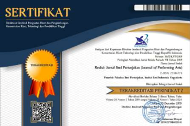Penggarapan Ulang Ilustrasi Musik Film “Jendela” Karya Randi Pratama; Studi Karya Tugas Akhir Larasati Rahma Aditiara
Abstract
Keywords
Full Text:
PDFReferences
Aditira, L. R. (2018). Garap Ulang Musik Film “Jendela” Karya Randi Pratama [Institut Seni Indonesia Yogyakarta]. In UPT Perpustakaan ISI Yogyakarta. http://digilib.isi.ac.id/5261/
Anggraini, S. N. (2015). “Aku yang Galau”: Refleksi Film Masa Kolonial hingga Awal Kemerdekaan. REKAM: Jurnal Fotografi, Televisi, Dan Animasi, 11(2), 79–92. https://doi.org/10.24821/rekam.v11i2.1295
Ariani, D. R., Neta, F., Pd, S., & Pd, M. T. (2021). Penerapan Teknik Color Grading dan Musik Scoring pada Tahap Paska Produksi Film Horor “ Waktu Terlarang .” Journal of Applied Multimedia and Networking (JAMN), 5(1), 1–13. https://jurnal.polibatam.ac.id/index.php/JAMN/article/view/2375
Budiman, C. (2013). Retorik dan Makna Ideologis Karya Instalasi dalam Film Opera Jawa Garin Nugroho. Resital: Jurnal Seni Pertunjukan, 14(1), 1–8. https://doi.org/10.24821/resital.v14i1.390
Cohen, A. J. (2014). Film Music from The Perspestive of Cognitive Science. In D. Neumeyer (Ed.), The Oxford Handbook of Film Music Studies (p. 696). Oxford University Press. https://doi.org/10.1093/oxfordhb/9780195328493.013.009
Costabile, K. A., & Terman, A. W. (2013). Effects of Film Music on Psychological Transportation and Narrative Persuasion. Basic and Applied Social Psychology, 35, 316–324. https://doi.org/10.1080/01973533.2013.785398
Creswell, Jo. W. (2013). Qualitative Inquiry & Research Design; Choosing Among Five Approaches (Third Edit). Sage publications. http://www.ceil-conicet.gov.ar/wp-content/uploads/2018/04/CRESWELLQualitative-Inquary-and-Research-Design-Creswell.pdf
Kelliher, F. (2005). Interpretivism and the Pursuit of Research Legitimisation : An Integrated Approach to Single Case Design. The Electronic Journal of Business Research Methodology, 3(2), 123–132. https://academic-publishing.org/index.php/ejbrm/article/view/1197
Kirby, P. (2021). Geography and Film Music : Musicology , Gender , and The Spatiality of Instrumental Music. Transactions of the Institute of British Geographers, 46(3), 570–583. https://doi.org/10.1111/tran.12443
Mudjiono, Y. (2011). Kajian Semiotika dalam Film. Jurnal Ilmu Komunikasi, 1(1), 125–138. https://doi.org/https://doi.org/10.15642/jik.2011.1.1.125-138
Muslim. (2016). Varian-varian paradigma, pendekatan, metode, dan jenis penelitian dalam ilmu komunikasi. Wahana, 1(10), 77–85. https://journal.unpak.ac.id/index.php/wahana/article/view/654
Nalan, A. S. (2017). Pertunjukan Musik Teatrikal “IBU” Produksi Teater Koma. Resital, Jurnal Seni Pertunjukan, 18(1), 13–26. https://doi.org/https://doi.org/10.24821/resital.v18i1.2443
Phetorant, D. (2020). Peran Musik dalam Film Score. Journal of Music Science, Technology, and Industry, 3(1), 91–102. https://doi.org/10.31091/jomsti.v3i1.967
Provenzano, C. (2006). Towards an Aesthetic of Film Music : Musicology Meets the Film Soundtrack. Music Reference Services Quarterly, 10(3), 79–94. https://doi.org/10.1080/10588160802111220
Purwacandra, P., & Nainggolan, O. . (2019). Sampling Suara Instrumen Musik sebagai Strategi. Jurnal Rekam, 15(1), 61–70. https://doi.org/https://doi.org/10.24821/rekam.v15i1.3232
Putri, I. P. (2013). Mendefinisikan Ulang Film Indie : Deskripsi Perkembangan Sinema Independen Indonesia. Jurnal Komunikasi Indonesia, II, 119–128. https://doi.org/https://doi/org/10.7454/jki.v2i2.7838
Rokhani, U., Salam, A., & Rochani-Adi, I. (2017). Konstruksi Identitas Tionghoa melalui Difusi Budaya Gambang Kromong: Studi Kasus Film Dikumenter Anak Naga Beranak Naga. Resital: Jurnal Seni Pertunjukan, 16(3), 141–152. https://doi.org/10.24821/resital.v16i3.1679
Rosar, W. H. (2009). Film Music---What’s in a Name? Journal of Film Music, 1(1). https://doi.org/https://doi.org/10.1558/jfm.v1i1.1
Steffens, J. (2020). The influence of film music on moral judgments of movie scenes and felt emotions. Psychology of Music, 48(1), 3–17. https://doi.org/10.1177/0305735618779443
Suryo P., R. (2017). Komponis Film Di Surabaya. AntroUnairdotNet, VI(2), 178–188. https://journal.unair.ac.id/AUN@komponis-film-di-surabaya-article-11479-media-134-category-8.html
Tanev, G., & Božinovski, A. (2014). Virtual studio technology inside music production. Advances in Intelligent Systems and Computing, 231, 231–241. https://doi.org/10.1007/978-3-319-01466-1_22
Vitouch, O. (2001). When your ear sets the stage: Musical context effects in film perception. Psychology of Music, 29(1), 70–83. https://doi.org/10.1177/0305735601291005
DOI: https://doi.org/10.24821/resital.v23i1.6943
Refbacks
- There are currently no refbacks.
This work is licensed under a Creative Commons Attribution 4.0 International License.



